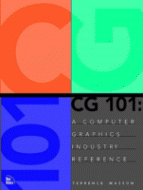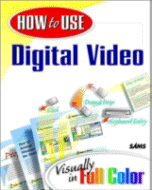Computer Book Reviews
Page One of TwoCG101: A Computer Graphics Industry Reference by Terrence Masson
New Riders, August 1999.Trade Paperback, 500 pages.
ISBN: 073570046X
Ordering information:
Amazon.com.
 This book acts as an encyclopedia,
dictionary and reference about computer graphics
and the computer graphics industry,
which can give graphic designers and
webmasters an upper hand when dealing
with graphics and design concepts.
This in-depth reference is divided into several main
computer graphic topics, including color
and light, painting and graphic design,
modeling, animation, compositing and
input and output. Each of these sections
provides information
about leading professionals and companies,
interviews with industry leaders, web links,
computer graphics job descriptions
and tips and tricks. Also provided in the
book are time lines, company profiles,
frequently asked questions
about computer graphics, job descriptions
and definitions of computer graphic terms.
CG101 is a reference that is jam-packed with useful information;
it should be
on the bookshelf of anyone involved in the
computer graphics industry. In addition, anyone considering
a career in computer graphics should find the
extensive information about computer graphics companies
and interviews with professionals very informative.
This book acts as an encyclopedia,
dictionary and reference about computer graphics
and the computer graphics industry,
which can give graphic designers and
webmasters an upper hand when dealing
with graphics and design concepts.
This in-depth reference is divided into several main
computer graphic topics, including color
and light, painting and graphic design,
modeling, animation, compositing and
input and output. Each of these sections
provides information
about leading professionals and companies,
interviews with industry leaders, web links,
computer graphics job descriptions
and tips and tricks. Also provided in the
book are time lines, company profiles,
frequently asked questions
about computer graphics, job descriptions
and definitions of computer graphic terms.
CG101 is a reference that is jam-packed with useful information;
it should be
on the bookshelf of anyone involved in the
computer graphics industry. In addition, anyone considering
a career in computer graphics should find the
extensive information about computer graphics companies
and interviews with professionals very informative.
How to Use Digital Video by Dave Johnson
SAMS, July 2000.Trade Paperback, 245 pages.
ISBN: 0672319233
Ordering information:
Amazon.com.
 Knowledge of digital video and video editing are skills
that will become highly valued as we enter days where
high bandwidth is commonplace, rather than a rarity.
Editing video on the computer used to be very
expensive and complex but with digital video, more
powerful and cheaper home computers and
special software programs people can now
edit movies on their home computers that is
similar to what is done in movie and television
studios. This guide introducers readers to digital video and
shows them how to incorporate it into their websites. It
also gives advice on video editing, adding
audio and music, polishing and adding special effects.
Full-color photographs and step-by-step procedures
help make it easy for readers to understand the
different methods. For example, one section in the book provides
photographs with detailed captions which tell readers how
to add titles to their video in several steps.
Other step-by-step
photo guides show readers how to add a watermark,
how to use motion blur, how to capture narration,
how to reduce camera shake, how to rearrange scenes
and how to color correct a scene. Instruction also
covers working with camcorders, storyboarding,
preparing your PC for video, editing your movie,
working with titles, adding credits, working with
audio, using still images, producing videotape,
publishing video to the Web and creating PowerPoint
slide shows.
The accompanying CD-Rom includes third-party
video editing software for Windows and Macintosh.
Knowledge of digital video and video editing are skills
that will become highly valued as we enter days where
high bandwidth is commonplace, rather than a rarity.
Editing video on the computer used to be very
expensive and complex but with digital video, more
powerful and cheaper home computers and
special software programs people can now
edit movies on their home computers that is
similar to what is done in movie and television
studios. This guide introducers readers to digital video and
shows them how to incorporate it into their websites. It
also gives advice on video editing, adding
audio and music, polishing and adding special effects.
Full-color photographs and step-by-step procedures
help make it easy for readers to understand the
different methods. For example, one section in the book provides
photographs with detailed captions which tell readers how
to add titles to their video in several steps.
Other step-by-step
photo guides show readers how to add a watermark,
how to use motion blur, how to capture narration,
how to reduce camera shake, how to rearrange scenes
and how to color correct a scene. Instruction also
covers working with camcorders, storyboarding,
preparing your PC for video, editing your movie,
working with titles, adding credits, working with
audio, using still images, producing videotape,
publishing video to the Web and creating PowerPoint
slide shows.
The accompanying CD-Rom includes third-party
video editing software for Windows and Macintosh.
Author Dave Johnson, a technology writer who writes for computer magazines and has published books on digital photography, has done an excellent job of explaining video editing and production concepts and techniques to readers. The vivid photographs help make the instruction crystal clear for amateur photographs at home. How to Use Digital Video is an excellent visual reference for beginners who are eager to get started with digital photography.
Computer Reviews
Page One | Page Two
Return to the September 2000 issue of The IWJ.
More from Writers Write
